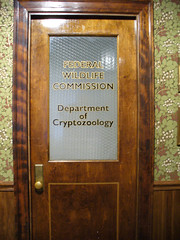Image via Wikipedia
Danny Casolaro, born in 1947 in McLean, Virginia, was a freelance writer and investigative journalist. And the sentence you just read is the only part of this story that isn’t bizarre.
Danny Casolaro was found dead in a Martinsburg, West Virginia hotel room bathtub in 1991. His wrists had been slashed 10-12 times, and he’d apparently left a note.
Casolaro’s family, though, insisted that his death had not been a suicide. He’d been squeamish about blood his whole life, and to slash his wrists made no sense to them. He’d given no indication that he’d wanted to kill himself. For several months prior to his death, Casolaro had received threatening, menacing phone calls from unknown callers – one promised to “cut his body and throw it to the sharks.” And his trip to Martinsburg, West Virginia had a strange purpose. He’d intended, according to Wikipedia, to
meet a source about a story he called “the Octopus.” This centered
around a sprawling conspiracy theory involving an international cabal, and
primarily featuring a number of stories familiar to journalists who
worked in and near Washington, D.C. in the 1980’s–the Inslaw
case, about a software manufacturer whose owner accused the Justice
Department of stealing its work product; the October Surprise theory
that during the Iran hostage crisis, Iran
deliberately held back American hostages to help Ronald
Reagan win the 1980 presidential
election; the collapse of the Bank of Credit and
Commerce International; and Iran-Contra.[2]
There certainly seems to be at least a kernel of something sinister and mysterious at the heart of Casolaro’s investigations. The Inslaw case led to three trials in federal court and two congressional hearings; the Justice Department was accused of “deliberately attempting to drive Inslaw into Chapter 7
liquidation; and of distributing and selling stolen software for covert intelligence operations
of foreign governments such as Canada, Israel, Singapore, Iraq, Egypt,
and Jordan; and of becoming directly involved in murder,” among other things. Inslaw, which had developed a people-tracking program called “Promis,” claimed that the government had stolen the software, created a secret backdoor in the program, and resold it to various entities.
And shortly before his death, “Casolaro told people that he was nearly ready
to reveal a wide-ranging conspiracy spanning the Inslaw case,
Iran-Contra, the alleged October Surprise conspiracy, and the closure of
BCCI.[7]
David Corn writes in The Nation that the papers Casolaro left
behind reveal few clues, except that he was in over his head, but was
tenacious.”
The day before he died, Casolaro was sighted with “a man described by a waitress as ‘maybe Arab or Iranian.'” In his alleged suicide note, written on a single sheaf torn from a legal pad, he wrote “To those who I love the most: Please forgive me for the worst possible
thing I could have done. Most of all I’m sorry to my son. I know deep
down inside that God will let me in.”
At Casolaro’s funeral, “as the ceremony drew to a close, a highly decorated military officer in U.S. Army dress reportedly arrived in a limousine.
Accompanied by another man in plain clothes, the military man
approached the coffin just before it was lowered into the ground, laid a
medal on the lid, and saluted. No one recognized either man and, to
this day, they have never been identified.”
Some enterprising conspiracy theorists have attempted to pick up the pieces and finish Casolaro’s work; a quick Google search will reveal theirs. It’s unlikely, though, that anyone has successfully unraveled Casolaro’s “Octopus” – and we’ll probably never find out whether it was an actual conspiratorial entity, or merely the product of a suicidal mind.
![Reblog this post [with Zemanta]](http://img.zemanta.com/reblog_e.png?x-id=d5006ef2-c3ea-4b99-acd3-1b770fa1b3d7)

![Reblog this post [with Zemanta]](http://img.zemanta.com/reblog_e.png?x-id=9e876339-7d0c-438b-bf47-781154ba4673)

![Reblog this post [with Zemanta]](http://img.zemanta.com/reblog_e.png?x-id=784591a9-dbf0-44ee-9ca8-47ccd0abcc25)



![Reblog this post [with Zemanta]](http://img.zemanta.com/reblog_e.png?x-id=ec12235f-99f2-4033-9ca6-0e3778e43ce3)

![Reblog this post [with Zemanta]](http://img.zemanta.com/reblog_e.png?x-id=b78d6028-8e44-4412-87a8-e98e2321b3a4)
